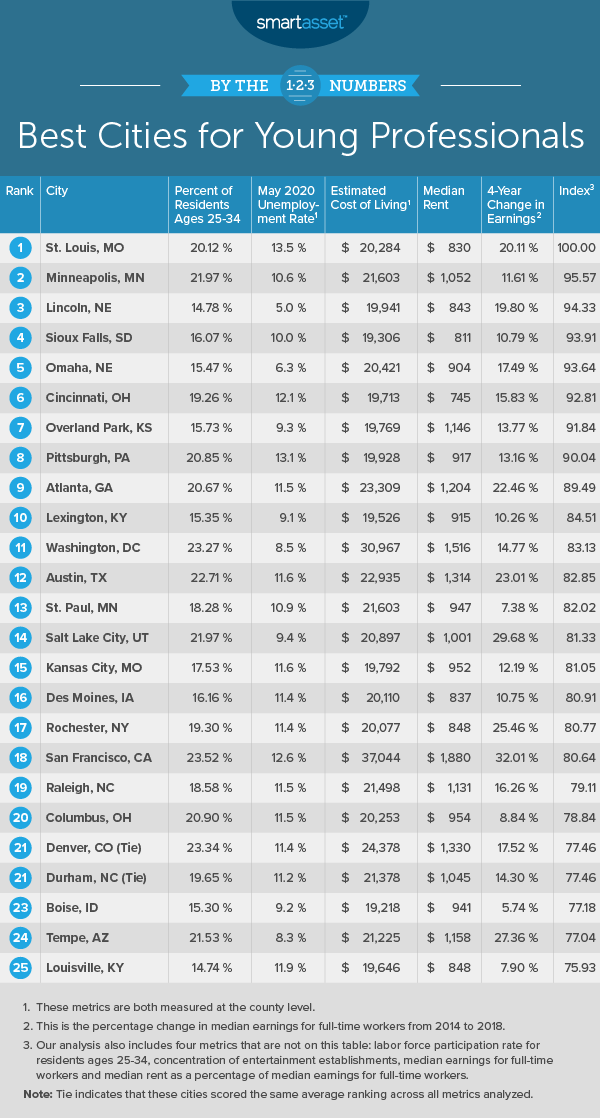Where Americans in the early stages of their careers choose to live can have an outsize influence on their professional development and trajectory. After all, not all places offer the same opportunities and quality of life. That’s why SmartAsset analyzed data from various sources to find the cities across America that are the best for young professionals.
SmartAsset considered 150 cities, comparing them across the following metrics: percentage of the population between 25 and 34, county level unemployment rate from May 2020, labor force participation rate for young professionals, median rent, cost of living, density of entertainment establishments, median earnings for full-time workers, four-year change in median earnings and median rent as a percentage of full-time workers earnings. For details on our data sources and how we put all the information together to create our final rankings, check out the Data and Methodology section below.
Key Findings
- Content to rent. The average rent across the top 10 cities in our study is $939, well under the national average of $1,058. And the young professionals in these 10 cities can meet that expense, too, as the average rent as a percentage of full-time workers’ earnings doesn’t exceed 23%, according to our data. By contrast, the average rent as a percentage of full-time workers’ earnings across all 150 cities in our study is 29.78%.
- Midwestern cities prove strong contenders for young professionals. If you’re at the start of your career and looking to move, consider the middle of the country, not the coasts. Seven of the top 10 cities in our study are in the Midwest, according to Census regional divisions. They stand out in two metrics in particular: median rent as a low percentage of full-time workers’ earnings and a high percentage of the population between 25 and 34.

Data and Methodology
To rank the best cities for young professionals, we looked at data for the 150 largest cities in the U.S. Specifically, we compared cities over the following nine metrics:
- Percentage of the population between ages 25 and 34. Data comes from the Census Bureau’s 2018 1-year American Community Survey.
- May 2020 unemployment rate. Data comes from the Bureau of Labor Statistics and is measured at the county level.
- Labor force participation rate for young professionals. This is the labor force participation rate for residents ages 25 to 34. Data comes from the Census Bureau’s 2018 1-year American Community Survey.
- Median gross rent. Data comes from the Census Bureau’s 2018 1-year American Community Survey.
- Cost of living. Data comes from the MIT Cost of Living Calculator and is from February 2020. This metric is measured at the county level.
- Entertainment establishment density. This is the percentage of all establishments in the area dedicated to arts, entertainment or recreation. Data comes from the Census Bureau’s 2017 County Business Patterns Survey.
- Median earnings for full-time workers. Data comes from the Census Bureau’s 2018 1-year American Community Survey.
- Four-year change in median earnings for full-time workers. This is the percentage change in median earnings for full-time workers from 2014 to 2018. Data comes from the Census Bureau’s 2014 and 2018 1-year American Community Surveys.
- Median rent as a percentage of full-time workers’ earnings. Data comes from the Census Bureau’s 2018 1-year American Community Survey.
First, we ranked each city in every metric, weighting all metrics equally. Then we found each city’s average ranking and used this average to determine a final score. The city with the highest average ranking received a score of 100. The city with the lowest average ranking received a score of 0.
This is SmartAsset’s fourth study on the best cities for young professionals. Check out the 2019 version of the study here.




















Add Comment